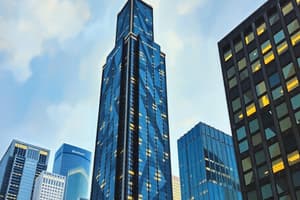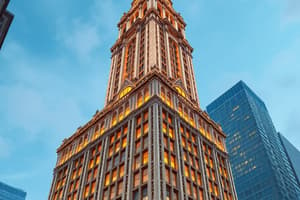Podcast
Questions and Answers
Which of the following is a key innovation that significantly contributed to the development of skyscrapers?
Which of the following is a key innovation that significantly contributed to the development of skyscrapers?
- Adoption of timber as a primary structural material.
- Implementation of complex ornamentation on building facades.
- Development of mass-produced steel and safe passenger elevators. (correct)
- Use of load-bearing walls made of reinforced concrete.
What is the primary function of curtain walls in modern skyscrapers?
What is the primary function of curtain walls in modern skyscrapers?
- To provide structural support, especially for withstanding lateral loads.
- To bear the weight of the floors above.
- To encase and protect steel beams from fire.
- To act as a non-load-bearing outer skin, allowing for larger window areas and improved aesthetics. (correct)
How did the introduction of zoning laws in 1916 influence the design of early steel-framed buildings?
How did the introduction of zoning laws in 1916 influence the design of early steel-framed buildings?
- They promoted taller buildings by easing height restrictions.
- They required setbacks in building designs to prevent the blockage of sunlight to the streets below. (correct)
- They encouraged the construction of wider buildings for increased occupancy.
- They mandated the use of specific construction materials.
What is the role of a Tuned Mass Damper (TMD) in skyscraper design?
What is the role of a Tuned Mass Damper (TMD) in skyscraper design?
What does 'vertical urbanism' refer to in the context of future trends in skyscraper design?
What does 'vertical urbanism' refer to in the context of future trends in skyscraper design?
What is the main goal of integrating intelligent building technologies into modern skyscrapers?
What is the main goal of integrating intelligent building technologies into modern skyscrapers?
How does a Building Automation System (BAS) contribute to the functionality of an intelligent building?
How does a Building Automation System (BAS) contribute to the functionality of an intelligent building?
Which of the following is a key element for achieving sustainability in intelligent buildings?
Which of the following is a key element for achieving sustainability in intelligent buildings?
What is the 'minimalist approach' in the context of 3rd generation (1940-1973) modern skyscrapers mainly focused on?
What is the 'minimalist approach' in the context of 3rd generation (1940-1973) modern skyscrapers mainly focused on?
What is the significance of hybrid structural systems in the evolution of high-rise buildings?
What is the significance of hybrid structural systems in the evolution of high-rise buildings?
What is a braced-frame structure primarily designed to resist?
What is a braced-frame structure primarily designed to resist?
What is the function of a horizontal bracing system in a braced-frame structure?
What is the function of a horizontal bracing system in a braced-frame structure?
What is a key limitation of braced-frame structures regarding flexibility?
What is a key limitation of braced-frame structures regarding flexibility?
What is the primary characteristic of a rigid frame system that allows it to withstand both vertical and lateral loads?
What is the primary characteristic of a rigid frame system that allows it to withstand both vertical and lateral loads?
What is a key advantage of using prefabricated rigid frame parts in construction?
What is a key advantage of using prefabricated rigid frame parts in construction?
Which of the following best describes the limitations of rigid frames in terms of architectural flexibility?
Which of the following best describes the limitations of rigid frames in terms of architectural flexibility?
In a dual structural system, what is the primary role of the moment frame?
In a dual structural system, what is the primary role of the moment frame?
What is the significance of ductility in the seismic performance of high-rise structures?
What is the significance of ductility in the seismic performance of high-rise structures?
What is a key consideration for integrating shear walls and moment frames in a dual structural system?
What is a key consideration for integrating shear walls and moment frames in a dual structural system?
Which of the following describes the structural system of the Shanghai Tower?
Which of the following describes the structural system of the Shanghai Tower?
What is a primary function of shear walls in a building's structural system?
What is a primary function of shear walls in a building's structural system?
What construction constraint is commonly associated with shear wall systems?
What construction constraint is commonly associated with shear wall systems?
Which material is commonly used to provide lateral strength and rigidity in concrete shear walls?
Which material is commonly used to provide lateral strength and rigidity in concrete shear walls?
What is the purpose of outriggers in a core structural system?
What is the purpose of outriggers in a core structural system?
What is the function of the core in a core and outrigger structural system??
What is the function of the core in a core and outrigger structural system??
Which term describes interior lateral structural systems that improve overturning stiffness and strength in high-rise buildings?
Which term describes interior lateral structural systems that improve overturning stiffness and strength in high-rise buildings?
What characterizes an infilled frame structural system?
What characterizes an infilled frame structural system?
What is a consideration when detailing and coordinating infilled frame structures?
What is a consideration when detailing and coordinating infilled frame structures?
What best describes a flat plate structural system?
What best describes a flat plate structural system?
Which design consideration is particularly important for punching shear in flat plate systems?
Which design consideration is particularly important for punching shear in flat plate systems?
Flashcards
Skyscraper Definition
Skyscraper Definition
A tall, habitable building with multiple floors for residential, commercial, or mixed-use purposes
Commercial Function
Commercial Function
Offices, retail spaces for business
Residential Function
Residential Function
Apartments, condos for living
Mixed-Use Function
Mixed-Use Function
Signup and view all the flashcards
Steel Frameworks
Steel Frameworks
Signup and view all the flashcards
Curtain Walls
Curtain Walls
Signup and view all the flashcards
Elevators
Elevators
Signup and view all the flashcards
Mass-Produced Steel
Mass-Produced Steel
Signup and view all the flashcards
Safe Passenger Elevators
Safe Passenger Elevators
Signup and view all the flashcards
Home Insurance Building
Home Insurance Building
Signup and view all the flashcards
Wainwright Building
Wainwright Building
Signup and view all the flashcards
Tubular Designs
Tubular Designs
Signup and view all the flashcards
Optimized Shapes
Optimized Shapes
Signup and view all the flashcards
Structural Damping
Structural Damping
Signup and view all the flashcards
Elevators
Elevators
Signup and view all the flashcards
Green Building Practices
Green Building Practices
Signup and view all the flashcards
Water Conservation
Water Conservation
Signup and view all the flashcards
Intelligent Building
Intelligent Building
Signup and view all the flashcards
Intelligent Building Institute (IBI)
Intelligent Building Institute (IBI)
Signup and view all the flashcards
Building Management Systems (BMS)
Building Management Systems (BMS)
Signup and view all the flashcards
Building Automation Systems (BAS)
Building Automation Systems (BAS)
Signup and view all the flashcards
Smart HVAC Systems
Smart HVAC Systems
Signup and view all the flashcards
Energy Efficiency
Energy Efficiency
Signup and view all the flashcards
Lower costs in intelligent building
Lower costs in intelligent building
Signup and view all the flashcards
Braced-Frame Structure
Braced-Frame Structure
Signup and view all the flashcards
Vertical Bracing System
Vertical Bracing System
Signup and view all the flashcards
K-bracing
K-bracing
Signup and view all the flashcards
Strengthening & Retrofitting of Braced Frames
Strengthening & Retrofitting of Braced Frames
Signup and view all the flashcards
Damage Mitigation of Braced Frames
Damage Mitigation of Braced Frames
Signup and view all the flashcards
Study Notes
Definition of a Skyscraper
- A tall, continuously habitable building that has multiple floors is considered a skyscraper
- These are for residential, commercial, or mixed-use purposes
- Modern skyscrapers must be at least 100 meters (330 feet) tall
- Supertall buildings reach 150 meters (490 feet) and above
- Buildings featuring 10-20 stories were considered skyscrapers, in the 1880s
Purpose & Key Features
- Primary functions include commercial, residential, and mixed-use spaces
- Commercial spaces are offices and retail areas
- Residential are apartments and condos
- Mixed-use is a mix of hotel, office, and retail
Key Features
- Steel frameworks replace thick masonry walls and provide stability
- Curtain walls allow for larger window areas and are not load-bearing
- Elevators are essential for high-rise accessibility
Pre-Skyscraper Era & Early Innovations
- Roman apartments had 7–8 stories
- Medieval Scottish tenements reached up to 14 stories
- Pre-skyscraper height was limited by thick masonry walls and a lack of water pumps
Key Innovations
- Mass-produced steel, invented by Henry Bessemer, allowed for lighter, stronger structures
- Safe passenger elevators, invented by Elisha Graves Otis (1850s), made upper floors practical for living and business
The First Skyscrapers
- Home Insurance Building in Chicago (1885) is considered the world’s first skyscraper
- It featured 10 stories (138 ft), later expanding to 12 stories
- William Le Baron Jenney designed it, and it was the first to use a structural steel frame
- The Wainwright Building in St. Louis (1890) was designed by Louis Sullivan, the "Father of Skyscrapers"
- Vertical bands were introduced to emphasize height
Global Expansion
- Chicago is the birthplace of skyscrapers and the skeleton frame
- New York City pushed height limits with buildings like the Chrysler Building and Empire State Building
- Europe had limited early adoption due to fire safety and aesthetic concerns
- Early European examples include Boerentoren (Antwerp, 1932) and Torre Piacentini (Genoa, 1940)
- Asia & the Middle East had a rapid skyscraper boom in the late 20th - 21st century
- Notable examples include the Burj Khalifa (Dubai), the world’s tallest building, and the Shanghai Tower (Shanghai)
Key Technological & Design Innovations
- Steel frames replaced thick masonry walls
- Curtain walls allowed for more glass, improving lighting & aesthetics
- Tubular designs improved resistance to wind & seismic forces
Aerodynamics & Wind Resistance
- Optimized shapes like tapered designs, setbacks, and curved corners reduce wind loads
- Structural damping utilizes Tuned Mass Dampers (TMDs) to absorb vibrations
Vertical Transportation
- Elevators are a key component in skyscrapers
- Modern advancements include double-deck and high-speed elevators for efficiency
Environmental & Social Impacts
- Green building practices include solar panels and wind turbines
- Water conservation includes rainwater harvesting and graywater recycling
- Increased energy efficiency through advanced HVAC systems and efficient lighting
- Urban density maximizes land use and reduces urban sprawl
- Cultural significance represents economic power & technological progress
Design Principles for Tall Buildings
- Structural stability uses braced tubes, diagrids, and outrigger systems to resist wind & earthquakes
- Efficient space utilization allows for multi-functional spaces for commercial, residential, and retail
- Human-centric design incorporates sky gardens and terraces for community interaction
Future Trends
- Smart technology for energy management, security, and automation
- Sustainable design for net-zero energy buildings with carbon-neutral materials
- Vertical urbanism connects skyscrapers with skybridges and shared utilities
Definition of an Intelligent Building
- An intelligent building integrates tech and systems
- It creatis an efficient, sustainable environment
- The IBI maximizes tech performance cost efficiency
- Intelligent buildings focus on automation, energy efficiency, and occupant comfort
Historical Context
- In the 1980s the goal was to integrate: Energy efficiency, Safety, Telecommunications and Automation
Core Components of Intelligent Buildings
- Occupants: Ensured comfort, security, and productivity using smart systems
- Structure and Systems are designed to minimize environmental impact and maximize adaptability
- Advanced Technologies use IT and Automation to enhance building performance, address user experience challenges and address energy and environmental issues
Key Features
- Building Management Systems (BMS) control lighting, HVAC, security, and energy usage
- Sensors & IoT devices monitor building efficiency in real-time
- Energy-efficient designs use solar panels, wind turbines, and smart energy systems
Green Building Rating Systems
- These systems encourage sustainable practices in building design, construction, and operations
- Green buildings reduce costs by improving energy and water efficiency
- They improve health by by improving air quality and lighting
- They support sustainability by alignment with global environmental goals
Global Rating systems
- LEED is Leadership in Energy and Environmental Design developed by the US Green Building council
- CASBEE evaluates environmental performance in buildings and urban areas
- BERDE(Building for Ecologically Responsive Design Excellence) is specifically for the Phillipines and built by The Phillipines Green Building council
Technologies in Intelligent Buildings
- Building Automation Systems (BAS) function to monitor and control elements like security as well as lighting
- BAS systems reduce overall costs but improves safety and comfort
- The systems also support remote monitoring
Building-Wide Systems
- Smart HVAC systems adjust based on weather and building use
- Advanced Energy Systems make use of renewable sources
- Lighting systems adjust based on occupancy and sunlight
Principles of Sustainability
- Energy Efficiency : Technology reduces energy waste and water is recycled
- Reduced Waste: Waste Management minimizes amount during construction and daily building use
- Sustainable Buildings: first Net Metropolis building in the Phillipines
Social & Financial Benefits
- Intelligent Buildings enhance the health of their occupants as well as providing communal spaces
- From a economical standpoint these buildings lower costs and increase property value
Future of Intelligent Buildings
- These buildings use AI and Machine Learning to predict energy needs and are designed to withstand climate change in the modern world
Introduction to The Evolution of High-Rise Buildings
- High-rise buildings have evolved through advancements in engineering, materials, and urbanization
- They are categorized based on architectural and technological innovations
Types of High-Rise Buildings
- Office Buildings mainly for operational and administrative functions
- Hotel Buildings which usually provide short term accommodations
- Residential Buildings Apartments and condominiums for long-term residential stays
- Mixed-Use Buildings Combine offices, residences, shopping centers, and hotels
Evolution of High-Rise Buildings: 1st Generation (1885-1916): Load-Bearing Structures
- Elevator Innovation: Introduced by Elisha Otis in 1854, enabling skyscraper construction
- Material Advancements: Steel frames replaced masonry, allowing taller structures
- Notable Architects: Louis Sullivan, Dankmar Adler, Daniel Burnham
- Curtain Wall System: Allowed flexible, lightweight facades
Key Features of 1st Generation High Rise Buildings
- Walls were thick and heavy to support building loads
- Brick, stone, and cast iron used for construction and Columns made of cast iron
- Floors built with wood presented a high fire risk and Fire hazards were common due to open stairways and elevator shafts
2nd Generation (1916-1940): Early Steel-Framed Buildings
- Zoning Laws (1916): Required setbacks to prevent blocking sunlight
- Art Deco Style: Emphasized geometric patterns and decorative facades.
- Notable Architects: William Van Alen (Chrysler Building)
- Structural Improvements: Taller buildings with central service cores
Key Features for 2nd Generation High Rise Buildings
- Steel-framed structures replaced thick masonry walls and concrete floors were introduced for fire resistance
- Masonry enclosures protected steel elements
3rd Generation (1940-1973): Modern Skyscrapers
- Key Developments are related to simplicity and functionality such as the work of the Second Chicago School
- Minimalist Approach: Focus on simplicity and functionality Notable Architects: Mies van der Rohe
- Structural Innovations with Tube-frame structures for stability
4th Generation (1973-Present): High-Tech Architecture
- High-Tech Design used prefabricated modules and energy-efficient systems
- Open Spaces: Atriums, roof gardens, and sustainable designs were popularized
- Sustainable Design allowed for the Use of natural ventilation and renewable energy Notable Architects: Norman Foster
- Notable Buildings: Commerzbank Tower, Burj Khalifa
5th Generation (1997-Present): Post-9/11 is focused on safety and innovations
- Developed energy efficiency and used advanced materials as well as systems
- Enhanced and used structural resilience to enhance Earthquake Resistance
Braced-Frame Structures For Buildings
- This system is used in buildings that face lateral loads, like wind and earthquakes to enhance stability
- This is done economically and Members are typically made of structural steel
Bracing Systems According to Orientation
- Vertical: transfers horizontal loads to the foundation
- Horizontal: transfers horizontal forces to vertical bracing
Types of Bracing
- Single Diagonals: inserters diagonal members into rectangular areas
- Cross-bracing: uses two diagonal connections at beam and column joints
- Knee Bracing: improves ductility of frames by placing knee elements at the top, bottom, or both ends of a brace
Additional Structural Considerations
- Bracing systems require regular maintenance and early repairs
- Cost surcharge can increase costs
- Flexibility may affect modifications to the structure
Advantages of Rigid Frame Structures
- Steel frames are strong yet lightweight
- Steel frames and concrete frames hold strength
Examples of Rigid frame Structures
Lever House (New York, 1952) Home Insurance Building (Chicago, 1885)
Function of Shear-Walls
- These walls transfer horizontal forces and provide support for tall structures
Structural Components
- These Systems reduce building deformation
- Load Distribution: distributes stress to the foundation
Types of Shear Walls
- Concrete: provides greater strength to structure
- Steel Plate: constructed with steel for both small and large buildings
Consideration for Design
- Wind: seismic designs are crucial for minimizing potential damage to exterior and interior
Structural Core Systems
- These help stabilize heavy resistance from top zones
- Helps with stability
Types of Support Systems
- Positioned far from center along corners or edges
- Positioned on the interior and exterior
Diagrids in Structural Systems
- A diagrid structure utilizes a triangular or rhomboid to eliminate structural damage efficiently Eliminates all vertical columns using to better the buildings foundation
Benefits
- Maximizes use of natural light which helps stabilize and secure
- Offers better rigidity
Facets of Designs
- Nodes are used to support all connections
- Core of the Main framework stabilizes with all aspects
Benefits Of Support Systems
- Increases rigidity through lighter loads, more flexible, while being more economically effficient
Complex Structural Desgin
- Balancing the loads on the frameworks is key for ensuring overall stability and reducing chances for collapse.
- Precision reduces unessesary costs
Studying That Suits You
Use AI to generate personalized quizzes and flashcards to suit your learning preferences.




